The study covered in this summary was published in medRxiv as a preprint and has not yet been peer reviewed.
Key Takeaways
-
An increased risk for diabetes was found with increased levels of fine particulate matter (PM2.5) and nitrogen dioxide (NO2), both air pollutants, in a national US cohort.
-
The increased risk remained even when exposure was restricted to levels below the US Environmental Protection Agency’s National Ambient Air Quality Standards (NAAQS).
-
Results for ozone (O3) were inconclusive.
Why This Matters
-
Both genetics and environmental exposures contribute to type 2 diabetes risk.
-
Studies of the association between air pollution and diabetes are few and often limited in quality or sample size.
Study Design
-
Study included 264,869,458 person-years of 41,780,637 fee-for-service Medicare (Parts A&B) enrollees ≥ 65 years of age in the contiguous United States during 2000-2016, followed annually until diabetes diagnosis, enrollment end, or death.
-
Annual estimates were obtained from prediction models for exposures to PM2.5, NO2, and warm-months O3, the three principal air pollutants linked to cardiometabolic health.
-
Exposure effects on diabetes risk were assessed and repeated for cohorts in zip codes with air pollution levels not exceeding NAAQS during the study period.
Key Results
-
A total of 10,024,879 diabetes cases were identified (3.8% of person-years).
-
Hazard ratios (HRs) for increased diabetes risk were 1.074 per 5-μg/m3 increase in PM2.5 (95% CI, 1.058 – 1.089) and 1.055 per 5-ppb increase in NO2 (95% CI, 1.050 – 1.060).
-
No linear association was observed for O3 (HR, 0.999; 95% CI, 0.993 – 1.004).
-
Stronger associations were seen with PM2.5 < 8.2 μg/m3 (25th percentile), followed by a plateaued association, and for NO2 < 36 ppb (94th percentile), followed by attenuated associations.
-
The O3 exposure-response curve was highly nonlinear with mostly negative associations.
-
Results remained similar and significant in cohorts exposed only to low levels of all three pollutants (33.7%, 96.4%, and 54.4% of annual PM2.5 and NO2, and warm-season O3 during the study period, respectively).
Limitations
-
Differences between people included and excluded from the cohort.
-
There was no data on diabetes type or individual confounders such as BMI, smoking, physical activity, or lifestyle.
-
Possible pollution misclassification errors.
Disclosures
-
The HERCULES Center, the Mount Sinai Transdisciplinary Center on Early Environmental Exposures, the National Institute on Aging, the National Institute of Environmental Health Sciences, and the US Environmental Protection Agency.
-
The authors have no disclosures.
This is a summary of a preprint research study “Long-term air pollution exposure and diabetes risk in American older adults: a national cohort study” written by Maayan Yitshak-Sade, PhD, of the Department of Environmental Medicine and Public Health, Icahn School of Medicine at Mount Sinai, New York City, and colleagues, and provided to you by Medscape. This study has not yet been peer-reviewed.
Source: Read Full Article
